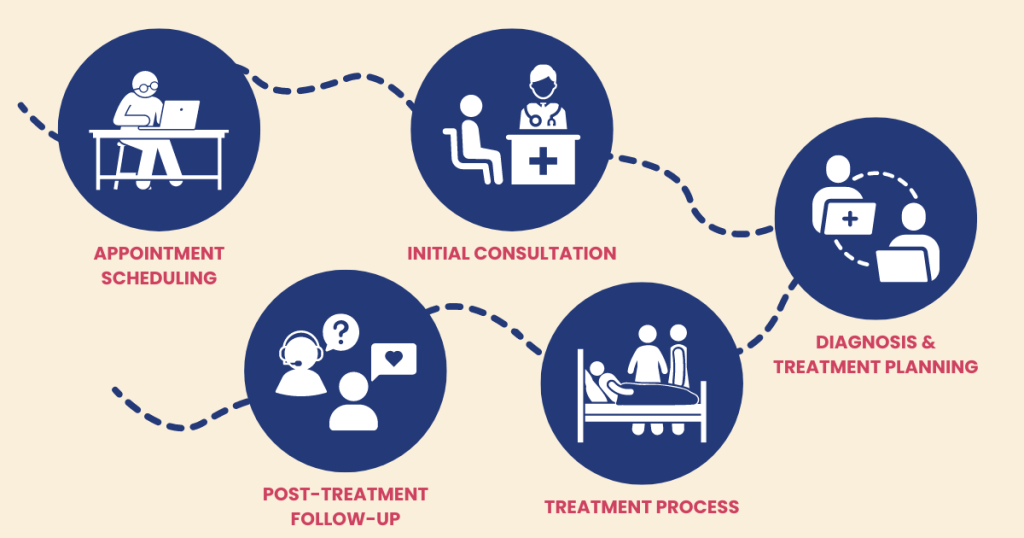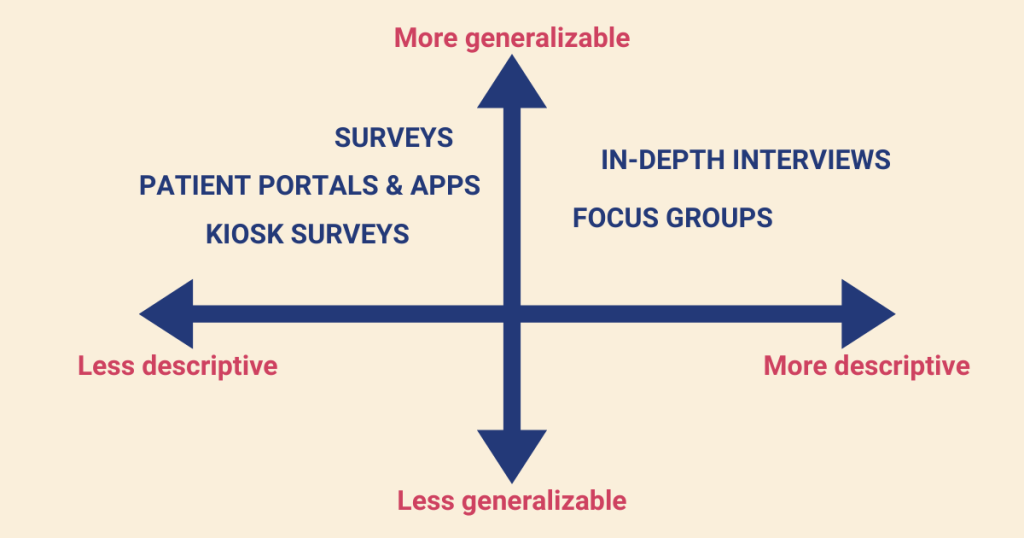A healthcare service that starts with the patient? That’s what patient experience is all about. It means combining the expertise of healthcare professionals with the voice of the patient to design services. This ensures a healthcare experience that meets the needs and expectations of patients and their families.
Healthcare providers should measure patient satisfaction continuously throughout the whole care journey. But it doesn’t stop there. It is crucial to make concrete improvements based on patient feedback. That’s how you ensure patients feel more supported and better cared for.
More informed and demanding than ever, patients want more than just effective treatments. They are looking for healthcare experiences that respect their needs and value their input. When patient feedback is integrated into service improvements, it improves the relationship patient-provider.
In healthcare, the customer journey is lifelong. Individual appointments or treatments are just one touchpoint. The full journey encompasses every interaction throughout a patient’s life. Each stage in the patient journey is an opportunity to provide a great experience and build loyalty.
In this article, we explore the concept of patient experience as a lifelong journey. We discuss the importance of measuring patient satisfaction at every touchpoint and the key metrics, tools, and strategies. The goal is to help healthcare providers to collect and act on patient feedback to nurture long-term relationships.
What is Patient Satisfaction?
Patient satisfaction measures how content patients are with the healthcare they receive. It is a combination of different factors, including the quality of care, communication with healthcare providers, the environment of the healthcare facility, and the overall experience during their healthcare journey. High levels of patient satisfaction are crucial because they are directly linked to better patient outcomes, increased patient loyalty, and a stronger reputation for healthcare providers.
Key Patience Satisfaction Metrics
To assess patient satisfaction, healthcare providers focus on some key metrics:
- Patient Satisfaction Score (PSS): A straightforward measure of overall patient satisfaction, typically gathered through surveys.
- Net Promoter Score (NPS): Assesses the likelihood that patients will recommend the healthcare provider to others, indicating overall satisfaction and loyalty.
- Patient Effort Score (PES): Measures how easy or difficult it is for patients to interact with healthcare providers and navigate their healthcare journey. It highlights the friction points that patients encounter, which can significantly impact their overall satisfaction and perception of care quality.
- Healthcare Effectiveness Data and Information Set (HEDIS): A tool used in the US by more than 90% of health plans to measure performance on important dimensions of care and service. It is a comprehensive set of standardized performance measures that provide insights into the effectiveness and quality of care.
What do patients want?
According to extensive research by the Picker Institute, these are the top 8 things patients want:
- Fast access to reliable health advice
- Effective treatment delivered by trusted professionals
- Participation in decisions and respect for preferences
- Clear, comprehensible information and support for self-care
- Attention to physical and environmental needs
- Emotional support, empathy, and respect
- Involvement of, and support for family and carers
- Continuity of care and smooth transitions

The Lifelong Patient Journey
The patient journey is not a single event but a continuous process that spans a patient’s lifetime and that of their family members. This journey includes every interaction a patient has with the healthcare system, from preventive care and routine check-ups to acute treatment and long-term management of chronic conditions. Recognizing this lifelong journey is essential for healthcare providers aiming to deliver consistent and high-quality care. By focusing on patient satisfaction at every touchpoint, providers can ensure that patients feel valued and supported throughout their entire healthcare experience.
Mapping the Patient Journey
Creating a detailed patient journey map is essential for understanding and improving patient satisfaction. By mapping out the various stages and interactions a patient experiences within the healthcare system, you can identify critical touchpoints where satisfaction should be measured and enhanced.
The first step is to define the scope, identifying the specific patient journey you want to map, such as a particular treatment process, a type of patient (e.g., chronic care patients), or a general overview of the healthcare experience. Then, break down the patient journey into distinct stages, from the initial contact to long-term care, with each stage representing a significant part of the patient experience.
Within each stage, list all the touchpoints where patients interact with the healthcare system. This includes direct interactions, such as consultations, and indirect interactions, such as navigating the hospital website. Understand the emotions, needs, and expectations of patients at each touchpoint to help identify pain points and opportunities for improvement.
Critical Touchpoints to Measure Patient Satisfaction
Measuring patient satisfaction at critical touchpoints is vital for continuous improvement. Here are some key touchpoints to focus on:
- Initial Appointment Scheduling: The first interaction sets the tone for the entire patient experience.
- What to Measure: Ease of scheduling, wait times for appointments, clarity of communication, and the professionalism of staff handling the appointments.
- First Consultation: The initial consultation is crucial for building trust and understanding patient concerns.
- What to Measure: Wait time, the thoroughness of the consultation, the ability of the healthcare provider to listen and address concerns, and overall satisfaction with the visit.
- Diagnosis and Treatment Planning: Accurate diagnosis and clear treatment planning are essential for patient confidence and adherence to medical advice.
- What to Measure: Clarity of information provided, involvement in decision-making, the comprehensiveness of the treatment plan, and the perceived competence of the healthcare provider.
- Hospital Stay or Treatment Process: Inpatient care and treatment processes significantly impact patient satisfaction and recovery.
- What to Measure: Quality of care, communication with healthcare staff, pain management, cleanliness of the facility, and overall comfort during the stay.
- Post-Treatment Follow-Up: Follow-up care is crucial for monitoring progress and addressing any ongoing issues.
- What to Measure: Timeliness of follow-up, effectiveness of communication, availability of resources, and satisfaction with post-treatment support.
- Long-Term Care and Ongoing Communication: Continuous care and communication are vital for chronic conditions and long-term patient relationships.
- What to Measure: Consistency of care, ease of accessing healthcare providers, quality of ongoing support, and overall satisfaction with long-term care management.

Patient Feedback Collection Methods
Collecting patient feedback is essential for measuring satisfaction and identifying areas for improvement. Various tools and methods are used in healthcare to gather this feedback, each with its own advantages and disadvantages:
- One-Time Surveys:
- Pros: Quick and easy to administer; cost-effective; provides immediate insights.
- Cons: Limited to a single point in time; may not capture the full patient experience; lower response rates.
- Focus Groups:
- Pros: Generates detailed, qualitative insights; allows for in-depth discussion and understanding of patient perspectives; facilitates interaction between participants.
- Cons: Time-consuming to organize and conduct; not scalable for large patient populations; potential for groupthink.
- In-Depth Interviews:
- Pros: Provides rich, qualitative data; allows for deep exploration of patient experiences and concerns; can clarify and expand on survey responses.
- Cons: Resource-intensive; time-consuming; requires trained interviewers; limited scalability.
- Kiosk Surveys:
- Pros: Convenient for collecting immediate feedback in healthcare facilities; accessible to patients during their visit; real-time data collection.
- Cons: Limited to patients present at the location; may require regular maintenance of kiosks; potential for lower participation if not well-promoted.
- Patient Portals and Mobile Apps:
- Pros: Facilitates ongoing engagement; easy for patients to provide feedback at their convenience; integrated into the patient’s routine; high response rates.
- Cons: Requires patients to have access to and familiarity with digital tools; may exclude less tech-savvy populations; ongoing maintenance and updates needed.

Real-Time Feedback Mechanisms
Real-time feedback mechanisms help healthcare providers address issues as they arise, leading to faster resolution and improved patient experiences. These mechanisms are becoming increasingly popular due to their immediacy and effectiveness.
- Continuous Automated Surveys: These can be triggered by different events to collect feedback at multiple touchpoints, such as post-appointment or discharge, providing timely insights.
- Benefits: Provides a comprehensive view of the patient journey; identifies trends over time.High response rates due to immediacy; and quick identification of issues allowing for prompt action.
- Patient Portals: Integrated into the healthcare provider’s system, these portals can collect ongoing feedback from patients.
- Benefits: Continuous engagement; easy for patients to use; provides a comprehensive view of patient satisfaction over time.
- Mobile Apps: Dedicated healthcare apps can offer surveys and feedback forms directly on patients’ smartphones.
- Benefits: Convenience for patients; high engagement rates; ability to collect location-based feedback.
3 AI Analytics Tools to Understand Patient Satisfaction
Advanced analytics and artificial intelligence (AI) play a crucial role in enhancing the understanding of patient sentiment and improving satisfaction. AI can analyze vast amounts of feedback data quickly and accurately, identifying trends and sentiments that might be missed by manual analysis. These technologies are essential in real-time feedback collection analysis. These are the top three tools for analysing patient feedback:
- Sentiment Analysis: AI can process patient feedback to determine overall sentiment, categorizing responses as positive, neutral, or negative. This helps healthcare providers understand general patient mood and areas needing attention.
- Benefits: Quick identification of widespread issues; deeper insights into patient emotions; scalable across large datasets.
- Predictive Analytics: By analyzing past feedback, AI can predict potential future issues and areas for improvement.
- Benefits: Proactive problem-solving; helps in resource allocation; improves long-term patient satisfaction.
- Text Analysis: NLP algorithms used in text analysis can interpret and categorize open-ended responses, providing context and deeper insights.
- Benefits: More comprehensive feedback analysis; identifies specific pain points and areas for improvement; enhances overall data interpretation.
By leveraging these advanced tools and techniques, healthcare providers can better understand patient satisfaction, leading to targeted improvements and better overall care experiences.
The Future of Patient Satisfaction Measurement
Understanding and improving patient satisfaction is essential for high-quality healthcare. Today’s patients seek a patient-centric approach that values their feedback and takes concrete action to improve their healthcare experience.
Patient satisfaction measurement and management will continue evolving with the integration of artificial intelligence and machine learning to enhance the accuracy and depth of patient feedback analysis. Predictive analytics will become more prevalent, allowing healthcare providers to anticipate patient needs and proactively address potential issues. Telehealth and digital health platforms will play a larger role in collecting real-time patient feedback, making it easier to gather insights from a broader patient base. Additionally, personalized care plans based on detailed feedback will become standard practice, ensuring that individual patient preferences and needs are consistently met.
Healthcare providers can ensure that patient satisfaction remains a top priority by adopting the strategies and tools discussed in this article to improve their patient satisfaction measurement processes and gain valuable insights into patient experiences. These insights can then be used to make targeted improvements, enhancing the overall quality of care and fostering stronger, more supportive patient relationships.
Did you like the post?
You might also like:

Surveypal
Everything you need to lead and improve your customer experience. Learn more at surveypal.com, or






